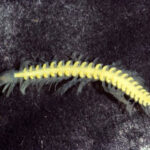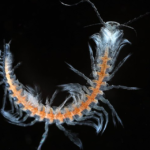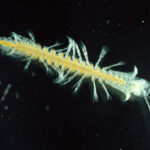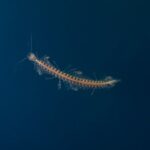Remipede
Although the name of these arthropods might bring about thoughts of multi-legged terrestrial animals such as millipedes and centipedes, remipedes are actually crustaceans. They do display many leg-like appendages, such as the similarly named centipedes and millipedes, however these animals are not at all closely related! Remipedes are more closely related to shrimp than myriapods, they simply share a similar name due to their similar appearance. The legs on a remipede are oar-shaped and help with swimming. These arthropods live in deep, saltwater caves.
Remipede CAVE DWELLER
Remipede caves are fascinating works of nature on their own. They’re water cave systems that connect to the ocean, giving them a salty bottom. Freshwater that pools from above collects on top of the denser saltwater, so the cave has freshwater literally floating on top of saltwater! Remipedes live inside the saltwater portion of the cave, which means the only way to observe them is to go cave diving.
This is a dangerous procedure, so living remipedes weren’t even discovered until right around 1980! Scientists were aware of fossil remipedes at that time, but since then more than 20 living remipede species have been discovered in these caves all over the world. There are probably more to find, but they’re not easy to reach.
Remipede CRUSTACEAN
A remipede’s body is composed of a head and a long, segmented trunk. In fact they bear quite the resemblance to bristle worms even though they’re not related. Although they don’t look like your typical crab, remipedes have some similarities to other crustaceans that help group them together. They have paired antennae and these, along with their legs and mouthparts bear striking anatomical similarities to other crustaceans. What’s more, they’re currently the only known venomous crustaceans out there!
Now, we don’t want to completely freak you out, so we’ll also mention that remipedes are also filter feeders! It really takes a lot of energy to swim all day and night, pumping those many, many legs as they move about underwater, so scientists think they eat while they move. Remipedes swim with their belly facing the water’s surface, and they’re active at any point during the day or night– it’s not like daylight is going to make an impact on them; they can’t see it!
Remipede APPEARANCE
Remipedes have no eyes. They wouldn’t need them as their world is entirely dark. However, they have other means of sensing the world around them, and they use these senses to find and hunt prey. Believe it or not, although the largest species don’t even reach 2 inches (5 cm) in length, remipedes are predators. They’ll swim up into the freshwater zone of the cave and stab shrimp with their venom-injecting front claws. They’re kind of like underwater centipedes, although their venom works like spider venom.
Once struck, the prey is immobilized and the venom works to digest the shrimp from the inside out. Remipedes have even been observed coiling around their quarry as they wait for the enzymes to take effect. Once liquified, the remipede sucks the shrimp’s juice up!
Remipede LIFE CYCLE
Little is known about how remipedes mate nor their lifecycle. What is known is that they possess both female and male reproductive organs. The female reproductive organs are located in their 7th segment and the male’s in the 14th. Adults have been found with as few as 15 trunk segments to more than 40, and the amount seems to vary even among members of the same species. Their larvae are free-floating and non-feeding.
They don’t have all their segments at birth, these grow over time, and some scientists believe they may just continuously grow throughout the remipede’s entire life. When they have been collected, larvae were found swimming in the transitional layer of brackish water between the fresh and saltwater zones of the cave system, however they’ve only been observed from one place, so there’s still a lot to learn.
For more information: Wikipedia, Animal Fact Files









